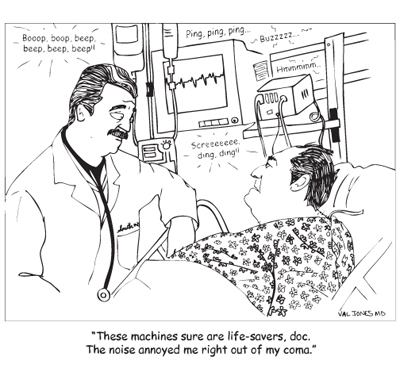
February 7th, 2010 by Peggy Polaneczky, M.D. in Better Health Network, Health Tips, News, Research
Tags: Bloating, Feeling Full, Obstetrics And Gynecology, Ovarian Cancer, Pelvic Pain, symptoms
No Comments »

 Thanks to Toni Brayer for pointing out this new study on ovarian cancer symptoms published in the Journal of the National Cancer Institute.
Thanks to Toni Brayer for pointing out this new study on ovarian cancer symptoms published in the Journal of the National Cancer Institute.
This study confirms previous studies which found that ovarian cancer, long thought to be a silent disease in its early stages, does indeed have symptoms. The problem is that those symptoms – bloating, urinary frequency, pelvic pain, early satiety – are common, non-specific and, according to this new study, 99% of the time not due to an underlying ovarian cancer.
That’s good news, of course, for women with these symptoms. But bad news for those hoping for a means of early detection for ovarian cancer, since early symptom recognition is neither sensitive nor specific enough to be useful as a screening test on a population basis. Read more »
*This blog post was originally published at The Blog that Ate Manhattan*
February 6th, 2010 by Jon LaPook, M.D. in Better Health Network, Expert Interviews, Health Tips, Video
Tags: AARP, Blue Zones, Exercise, Healthy Living, Jon LaPook, Longevity, Weight Loss
No Comments »
If you want to improve the health of Americans, why not look around the world for places where people live the longest, healthiest lives and try to copy whatever it is they’re doing? That’s exactly what Dan Buettner has done. He is the author of The Blue Zones: Lessons for Living Longer From the People Who’ve Lived the Longest.
Examples of areas he calls “blue zones” are Sardinia, Okinawa, Costa Rica (the Nicoya Peninsula), Ikaria (a Greek island), and Loma Linda, California. Things residents have in common include exercising regularly, eating more vegetables and less meat, engaging in social networking, and having a sense of purpose. Read more »
February 5th, 2010 by Joseph Scherger, M.D. in Better Health Network, Health Tips
Tags: Cardiology, Exercise, Heart Disease, Heart Health, Ideal Cardiovascular Health, Primary Care, Weight Loss
No Comments »

You too can have ideal cardiovascular health. What is that you may ask? The American Heart Association has come out with a new report that defines it.
Ideal cardiovascular health means you do all of the following:
1. You do not smoke
2. You are not overweight (normal body mass index, or BME less than 25)
3. You get regular physical activity, about 5 hours a week
4. You eat a healthy diet low in saturated fats and simple sugars
You also have the following: Read more »
*This blog post was originally published at eDocAmerica*
February 5th, 2010 by Gwenn Schurgin O'Keeffe, M.D. in Better Health Network, Health Tips
Tags: Children, Drinks, Empty Calories, Food and Nutrition, Juice, kids, Nutrition, Obesity, Pediatrics, Pop, School Lunches, Soda, Sugar, Weight Gain
1 Comment »

Bloomberg recently posted that the New York school system is going to eliminate whole milk from their cafeterias to cut calories. 4.6 billion calories and 422 billion grams of fat will be eliminated from the menu by this plan. A good plan for the kids involved. Well, at least a good start.
As the post notes, schools nationwide are working diligently to tweak menus and offer healthier alternatives for kids in all grades from elementary school to high school. Some schools, such as the school district my kids attend, use electronic payment systems where parents can log-on to see what their kids have purchased. We’ve found this helpful at times to remind our kids about healthy alternatives and how to order a healthy lunch, especially on days when they find them selves either completely ravenous or with little time, which can easily happen in a typical school day. Read more »
*This blog post was originally published at Dr. Gwenn Is In*
February 4th, 2010 by RamonaBatesMD in Better Health Network, Health Tips, Research
Tags: Belly Button, How To Reconstruct, Neoumbilicoplasty, Plastic Surgery, Scar, Umbilicus
No Comments »


The umbilicus is perhaps the only scar that all of us want. The umbilicus forms after birth as a result of the placental cord being transected as the infant is “detached” from his/her mother. As the stump of the cord necroses, the scab falls away as the base heals leaving a scar: the umbilicus.
The umbilicus has been described as a depressed scar surrounded by a natural skin fold that measures 1.5 to 2 cm in diameter and lies anatomically within the midline at the level of superior iliac crest.
Neoumbilicoplasty in simple terms is the creation or reconstruction of a new umbilicus to replace the missing or deformed umbilicus. (absence of defined umbilicus, photo credit) Read more »
*This blog post was originally published at Suture for a Living*
 Thanks to Toni Brayer for pointing out this new study on ovarian cancer symptoms published in the Journal of the National Cancer Institute.
Thanks to Toni Brayer for pointing out this new study on ovarian cancer symptoms published in the Journal of the National Cancer Institute.















